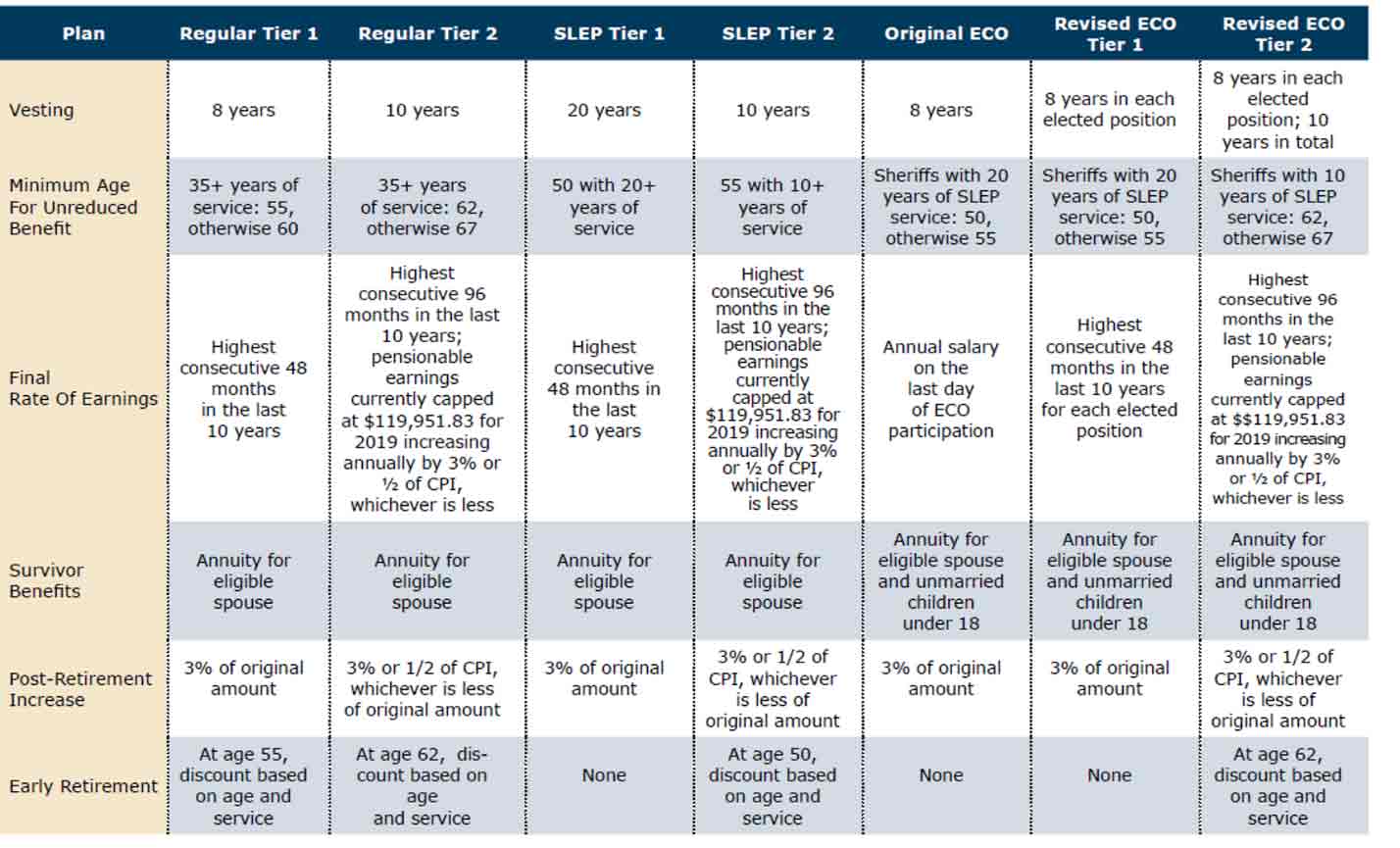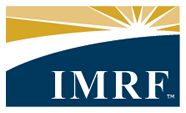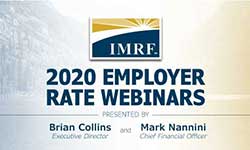View the 2020 program presented by IMRF Executive Director Brian Collins and Chief Financial Officer Mark Nannini.
2020 Rate Webinar Resources
IMRF conducted three 2020 Employer Rate webinars on April 30 at 10 AM, May 6 at 11 AM and May 12 at 2 PM. Brian Collins, Executive Director, and Mark Nannini, Chief Financial Officer, provided an in-depth review of the impact of year-end financial and actuarial data on IMRF, and the data's estimated impact on individual IMRF employers. During the presentation, attendees were invited to submit real-time questions, which were addressed before the conclusion of the program.This recap of the Employer Rate webinar includes a link to view the webinar program in its entirety, a link to download the presentation's slides, attendee comments, and a transcript of the questions posed during the program, with detailed answers.
Attendee Comments
- "Very well done."
- "I thought it was very informative and the data covered was explained effectively."
- "Excellent presentation! It was clear, concise and very informative. Enjoyed the webinar format as well."
- "Terrific information with extremely knowledgeable presenters!"
Question and Answer Presentation
Q1.: How does this current market downturn (with COVID) compare with 2008? What does a potential recovery look like for IMRF? Will the impact on IMRF be comparable?
A1.: In 2008, at the bottom of the Great Recession, IMRF experienced the greatest loss in the history of the fund and was down 24%. These current market losses are substantial, with the fund down 13% in the first quarter of 2020. One significant difference is the cause of the situation. In 2009, the recession was fueled by a real estate crisis, and it cascaded into other sectors of the economy.
It is going to take at least another six months to see how much of a bounce back we will get. The federal government has pumped $3 trillion or more into the market. The European Union has put a similar amount into the European markets. We have a lot of uncertainty right now. IMRF’s portfolio is highly diversified by industry, investment type, and region of the world.
The key is that Dec 31st is the measurement date. Between now and the end of the year, a lot can happen. Slide 11 shows we’ve already recovered several billion dollars.
The 2022 employer rates will be based on the 2020 market gain or loss as of Dec 31st 2020. As tough as this year is, we are coming off a strong 2019. We smooth our gains and losses over a 5-year period, which will help moderate the effect of any potential losses during 2020.
Q2.: Given the market losses in 2020, will the 2021 IMRF employer rate be adjusted upward to reflect the current downturn?
A2.: No, employer rates for 2021 will be set based on the market return during 2019. None of the current turmoil will be reflected until the 2022 rates. We can be optimistic and hope there is an improvement by the Dec 31st measurement date.
The market may rebound, and the number at end of year is the only one that matters. Market losses in 2020 will not be reflected until 2022. Also, we smooth our gains and losses over a 5-year period, which will reduce volatility in the rates from year-to-year.
Q3.: Has there been discussion regarding reducing the investment assumption rate from the current 7.25%?
A3.: There has not been any recent discussion on changing this rate. The Board of Trustees reviews the funding each December, but no change has been discussed to date.
Q4.: Brian said IMRF investments perform well on an absolute but also relative basis. Tell me more about how you know our investments do well on a relative basis. How do you measure this?
A4.: Looking at slide 10 of this webinar, this graph shows the market returns of the largest public pension plans in the nation, representing approximately $4 trillion of assets run by fund managers across the country. You see IMRF is out-performing all funds as a whole. Also, at the money manager level, we set performance goals and hire/fire managers based on performance to help ensure that we meet or exceed our assumed rate of return.
This question was addressed at the May 12 webinar, which is available on our website.
Q5.: What has IMRF received as an annual return over the last 10-20 years (or longer)? Does IMRF report asset balances and investment returns quarterly on the website? .
A5.: You can find a great deal of information on our website: https://www.imrf.org/en/investments/about-investments/reports. For example, in the Fourth Quarter 2019 and 2019 Annual Report on page 6, we see that IMRF’s 10-year net return was 8.82%. Also please see slide 7 of this webinar.
Q6.: Tell me about your process for making portfolio investment decisions. How do you ensure that you are getting a good deal in terms of investment management fees?
A6.:We negotiate fiercely, so that our fees are lower than the industry average.
We decide on our asset allocation by working with our consultants and our internal investment team. We decide how much money will be in stocks, bonds, internationally, etc.
We choose money managers to invest in each category. We have over 100 asset managers. We have specific targets both in risk tolerances and investment return goals, and we monitor how they are doing to ensure we stay on course with our goals. We also let asset managers go and replace them if they are not hitting our targets.
Q7.: If someone works for an IMRF employer for 20 years, in an IMRF qualified position, and then leaves and works 5 more years for a new IMRF employer, how is the liability to each employer determined?
A7.: The liability is spread between both employers, and there’s a calculation that we use to determine the percentages. Each situation is unique, however, so please contact IMRF staff for the particulars of the situation, and we can provide the exact numbers.
Q8.: What is the difference in years as noted in the 22-year closed amortization period (slide 17) vs 37 years to distribute pension cost (slide 18)? Aren’t pension costs distributed over 22 years? Has IMRF always distributed pension cost over 37 years?
A8. The two different concepts in this question need to be addressed separately.
- The amortization period’s objective is to reach 100% funding in the current 22nd year of a closed amortization period. The initial amortization period of 30 years began in 2012.
- On slide 18, the “37 years” example explains how (during a typical career) the funding as described is necessary for 100% funding from employee contributions, employer rates, and interest income earned. The objective is to have the proper annual funding reach the present value of the future benefit in the reserve for proper funding at retirement.
Q9.: What is an example of something that would change the rate calculation from the preliminary statement to the final rate notice?
A9.: Those are typically entries that are made the last week of the prior year, such as a refund or beginning retirement with IMRF not receiving the proper forms, or an Early Retirement Incentive (ERI). If we do not receive the documentation in a timely manner, an adjustment is needed. Staff looks at prior correspondence we receive to make the adjustment.
Contact us if you have questions, and IMRF staff will look at it with you.
Q10.: What caused the employer rates to increase for 2021 when the market did so well in 2019?
A10.: The average employer rate decreased from 10.91% to 10.62% in 2019. Each employer is different and is affected by various conditions like retirements, refunds, ERIs, buyback of service, and several other factors.
Q11.: What is the average employer contribution rate for Illinois and the country?
A11.: Rates will vary across the state and nation for various reasons, including differences in benefit structures. The average contribution rate for the IMRF Regular Plan in 2019 is 10.62%.
Q12.: How can employers find out the number of Tier 1 and Tier 2 employees in their IMRF plan?
A12.: Please contact IMRF to find out your exact information.
Q13.: I am the agency’s authorized agent and am retiring in a month. Does the Board need to pass a resolution to have my replacement approved as an authorized agent?
A13.: The governing body of the employer needs to pass a resolution to approve a new authorized agent. Please forward that information to IMRF, so we have their contact information.
Q14.: If an employer wants to make additional contributions to the employer reserve, is there a better time of year to make these contributions?
A14.: The recommended time to make a contribution is in December. Employers do not start to earn interest until the first day of the following year. So keep the money and earn interest, and then forward the money to IMRF in December. Please avoid the last week of December, though, since if funds are not properly received by Dec 31st, the employer will not earn interest for another 366 days.
Q15.: Do you anticipate the Voluntary Additional Contribution (VAC) rate to change?
A15.: The VAC rate will continue to match the assumed rate of return.
Q16.: Can you give an update on the timing for release of the GRS vs IMRF Reconciliation Adjustments, the Census Attestation, and the Schedule of Fiduciary Net Position Changes?
A16.: We are currently compiling and auditing these schedules. We hope to have these available by the end of May.
Q17.: At our employer, we have some employees that are already retired, but are continuing to work and still have to pay into IMRF. Have you ever considered an Opt Out plan for these retirees?
A17.: Retirees that are working in IMRF-qualified positions have to pay into IMRF. They need to be aware of the standard hours and not exceed them to prevent affecting their pensions. New legislation would need to be passed to change this process.
Q18.: Will the 13th payment percentage decrease this year?
A18.: Each July, eligible retirees and surviving spouses receive a Supplemental Benefit Payment, also known as the "13th Payment." IMRF staff estimated that the 2020 13th Payment will be 26.085% of a retiree’s June benefit payment. This is a similar percentage as in 2019.
Q19.: What are some of the differences in the benefits for Tier 1 and Tier 2? Since the benefits for Tier 2 are less than Tier 1, will Tier 2 reduce employer costs significantly in the future?
A19.: Below are the key differences between Tier 1 and Tier 2 by benefit plan. It costs about 40% less to provide a Tier 2 pension versus a Tier 1 pension. The reduced costs are already depressing employer contribution rates, and will continue to do so.

Q20.: Is IMRF still phasing in an open amortization period?
A20.: Not at this time.
Q21.: On slide 10, why does IMRF use the 20-year average performance rather than the 10-year or the 25-year columns on each side?
A21.: The 10-year and 25-year are not reflective of IMRF’s historical performance. For the ten-year average, the data from 2008 is not included, but 2009 is. The 25-year average is inflated by the tech bubble. The 20-year is a better indicator of IMRF’s typical performance.
Q22.: Does everyone pay the same member contribution rate? How long has the rate been at its current level?
A22.: Every Regular Plan Tier 1 and 2 member pays the same, 4.5% of pay. Elected County Official (ECO) Plan and Sheriff’s Law Enforcement Personnel (SLEP) Plan are 7.5%. The member rates for members already in a plan cannot go up. These have been the same for decades, as per the Illinois Pension Statutes.
Q23.: IMRF is 91% funded. What does that mean exactly? What is considered a strong funded status in your industry?
A23.: If a pension is 100% funded, it would already have all the money it needed to pay all the liabilities (pension benefits) it had in the future. That is, if the plan hit its assumed rate of return.
Since it depends on how the markets are performing, it is rare to hit exactly 100%, but that is IMRF’s long-term goal. In our industry, it’s considered excellent to be over 90% funded. Maybe 20% of all funds are currently in the 90% range. A funded status above 80% is considered healthy within the pension industry. Funds under 80% are facing some significant risk.
Q24.: If someone asks what our funded level is, do we give them the GASB 50 or 68 funded level?
A24.: GASB 50 does not include the funding for the annuitants, who are 100% funded upon retirement. We recommend the use of GASB 68, as that is the preferred method under GAAP and GASB. For most employers, the GASB 68 funded status will be greater than the GASB 50 funded status.
Q25.: Regarding the GASB 50, 68, and Soc-1 type 2 reports, do we need to provide these to our Board members?
A25.: Be sure to give the reports to your auditors, and include this information in your published financial statements. However, it is up to each employer whether to give this information to their Board.
Q26.: On the personal statement of benefits, under the pension estimates section, specifically estimates calculated under the money purchase formula, are those numbers shown as a future value projection or at a present value basis?
A26.: They are shown at present value.
Q27.: When will you open up the phone lines for members to reach a person?
A27.: With our call center temporarily shut down due to the pandemic, IMRF implemented a process allowing members who don't have email access to leave a voicemail for a call back from staff.
Q28.: Will there be an IMRF app in the future?
A28.: IMRF is modernizing the technologies and processes it uses to administer the pension system. This project will improve the way employers and members interact with IMRF. More transactions will go online, enabling faster and more modern communication.
IMRF will share information as the project progresses.
Q29.: Can you provide Member Access password resets in another way other than mail?
A29.: Contact us, verify your identity, and we will work with you to set a new password.



